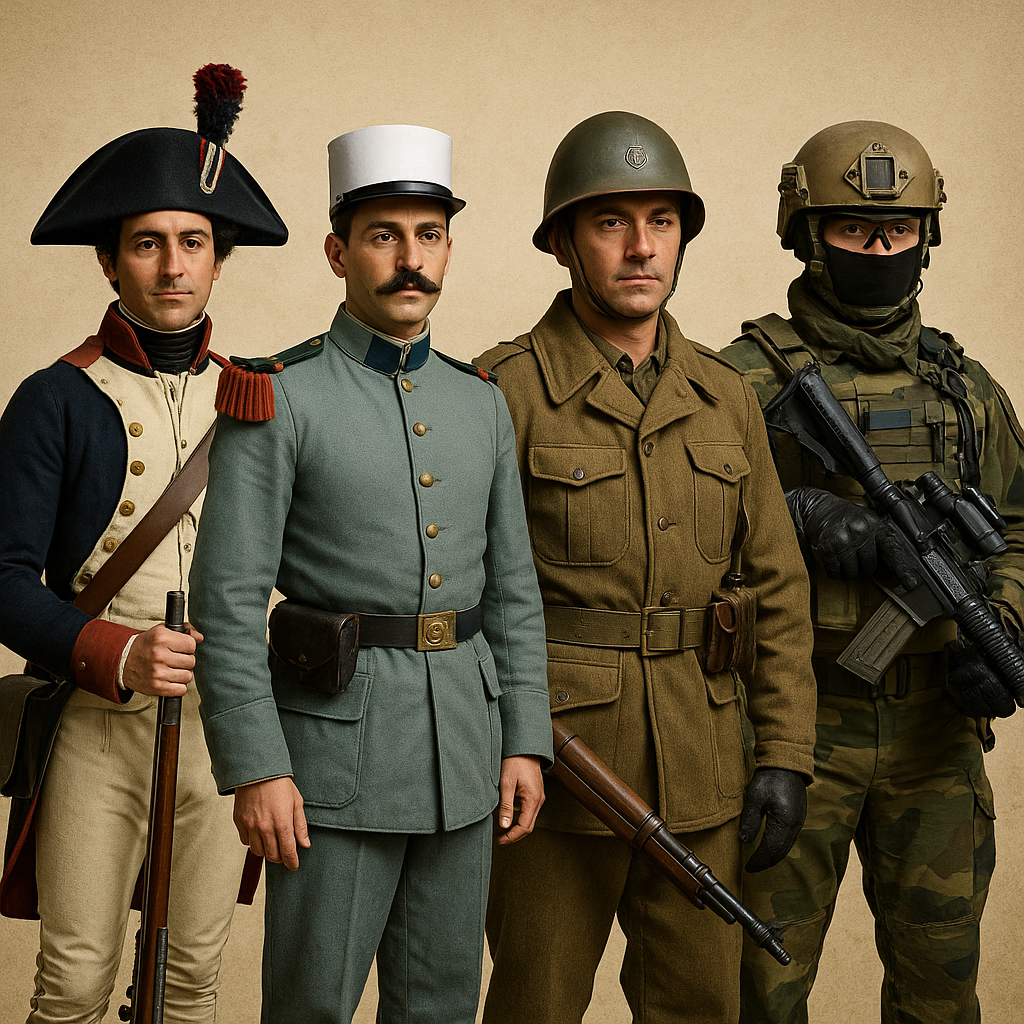
French Military Uniforms: A Timeless Legacy from the Battlefield to the Modern Era
Published on Jul 01, 2025
Introduction: The Symbolism Behind the Uniform
Military uniforms do more than provide protection—they embody the spirit, discipline, and history of a nation's armed forces. French military uniforms, in particular, are known for their elegance, practicality, and evolution over the centuries. Understanding their journey offers insight into France’s military strategies, colonial expansions, and modern defense capabilities.
1. Early History: French Uniforms in the French and Indian War
One of the earliest recognizable French military uniforms appeared during the French and Indian War in the mid-1700s. French troops operating in North America during this period wore distinctive outfits designed to be both durable and symbolic.
Characteristics of 18th-Century French Uniforms:
- Deep blue wool coats with white facings
- Red or white breeches and vests
- Tricorn hats edged with white trim
- Regiment-specific buttons and cuff patterns
These uniforms were created not only for identification but also for function in North America's diverse climates. Though not as advanced as modern combat gear, they offered soldiers a visual presence and fostered a sense of regimental pride.
2. 19th Century to Early 20th Century: Napoleonic Grandeur and the Rise of the Foreign Legion
The 1800s marked the height of Napoleonic influence, which introduced more structured and colorful French uniforms. Formal silhouettes, ornamental trim, and prominent accessories characterized these designs.
Napoleonic and Post-Napoleonic Features:
- Bold epaulettes denoting rank
- Shako hats replacing earlier tricorns
- Gold or silver buttons and sashes
- Uniform modifications for colonial campaigns
This era also saw the birth of the French Foreign Legion in 1831. The Legion's uniforms were developed to endure harsh desert conditions in North Africa. Lightweight tunics, the famous white kepi, and functional belts became staples for legionnaires. These uniforms signaled France’s growing global presence and adaptability in various terrains.
3. 20th-Century Warfare and Tactical Innovation
World War I and II brought about significant changes in military uniform design worldwide. For France, this meant moving from traditional parade-style uniforms to more practical, camouflaged combat attire.
WWI & WWII Shifts:
- Earth-toned uniforms to blend with the surroundings
- Adrian helmets for head protection
- Simpler design, prioritizing movement and concealment
- Reduction in ornate elements like sashes and gold braid
By this point, French military uniforms became more utilitarian. The emphasis was on function, survivability, and mass production. However, the national identity and pride remained woven into each design.
4. The Modern Look: French Special Forces Uniforms
Today, French special forces operate globally in diverse environments—from dense forests to urban zones and desert terrain. Their gear is built with cutting-edge materials and designs to maximize effectiveness in high-stakes operations.
Features of French Special Forces Uniforms:
- Multi-environment camouflage (CE pattern or desert camo)
- Flame-retardant, breathable fabrics
- Tactical vests with MOLLE systems
- Advanced headgear with communication and night vision integration
- Lightweight, water-resistant combat boots
The evolution from wool and buttons to Kevlar and microfibers highlights how far French military uniforms have come. The modern special forces uniform is a result of years of battlefield experience and continuous innovation, combining functionality with France’s commitment to excellence.
5. The French Foreign Legion Uniform: Enduring Identity
Among the most iconic military uniforms in the world is that of the French Foreign Legion. Known for its resilience, discipline, and mystique, the Legion has maintained unique elements of its dress throughout the decades.
Key Uniform Elements of the Legion:
- White kepi hat, symbolic of legionnaire pride
- Green and red epaulettes
- Sand-colored fatigues for desert operations
- Polished leather boots and web belts
These pieces aren't just uniforms—they are badges of honor. Wearing them signifies a soldier’s place in one of the most storied and demanding military units in the world.
6. For Collectors and Reenactors: The Appeal of Authenticity
French military uniforms are immensely appealing to collectors, reenactors, and military historians. Whether staging a scene from the French and Indian War or curating a display of modern tactical gear, accuracy and authenticity matter.
Tips for Building a Collection:
- Research the regiment and historical period
- Focus on material quality and stitching accuracy
- Look for authentic accessories like headgear, belts, and boots
- Understand the evolution of rank insignia and badges
Collectors often find French uniforms particularly rewarding due to their aesthetic and historical depth. Every button, seam, and emblem tells a story—from colonial skirmishes to elite counter-terrorism missions.
7. The Legacy Lives On
French military uniforms reflect the broader history of France itself—a blend of tradition, revolution, resilience, and innovation. These uniforms are more than attire; they are cultural artifacts that continue to inspire militaries, filmmakers, and fashion designers around the world.
Whether you're interested in historical battles or modern warfare, studying French uniforms offers a tangible connection to military evolution and national identity.
Conclusion: Tradition Meets Tactical Excellence
From the elegant uniforms of the French and Indian War to the high-tech gear of today's French special forces, France's military apparel continues to evolve with the times while maintaining a deep connection to its roots.
Whether you're a collector, historian, reenactor, or simply curious, exploring French military uniforms offers a window into centuries of strategy, style, and service.
